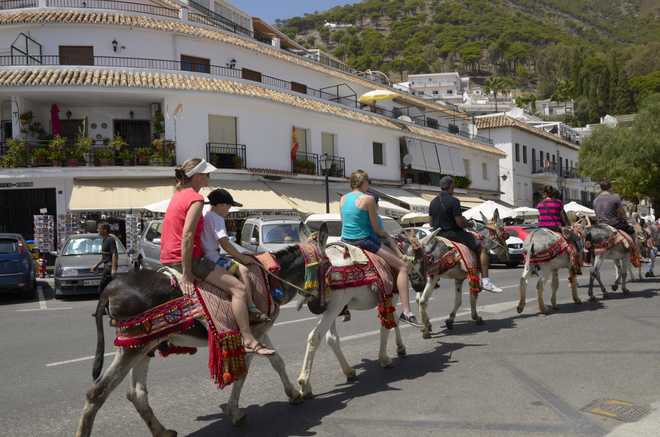The donkey express
Ranjita Biswas
In this age of fast-moving cars, intercontinental flights and superfast trains, where does the poor donkey, a transport ‘system’ of yore, stand? But that’s what you will encounter in Mijas, a pretty little village — pueblo, perched on a hillock. It is near the famous Costa del Sol beach areas off Malaga city. Though you can see cars going up and down the meandering lanes of the town between the pristine white buildings, the donkey ‘taxi’ is quite popular too. And, of course, it’s a magnet to tourists looking for something different in this digital age.
Malaga is in the Andalusia region in southern Spain. Mijas, near another famous resort city Marbella, is about 45 minutes drive from there. A day trip to both the places can be planned from Malaga to get a taste of Costa del Sol.
A statue of a donkey greets as you alight in front of the tourist office located at a lower level and the burro taxi stand is just across. It’s reminiscent of the early 1900s when the beast of burden doubled as a mode of transport to go up the hilly roads. When tourists started visiting this area from other parts of Europe, they often took back as souvenir a straw donkey.
Times have changed but Mijas has retained the donkey ‘burro’ taxi as a salute to the old days, and obviously, as a tourist attraction. As the story goes, in the 1960s when the farmers returned home with their donkeys, they were often accosted by tourists requesting to be photographed with them, and also, if possible, give a ride. The farmers soon found out that the rides with some tips worked out better as earnings than toiling hard in the farm. So they decided to introduce it as a formal ‘taxi’ service. Today they also need to have licences to operate their donkey-pulled carts.
The donkeys are profusely decorated with colourful gear. For one visiting from India, they would seem like the ceremonial garbs elephants and camels are dressed up with during festivals.
The ride introduces the visitor to the pretty village with cobbled stones skirted by attractive houses with hanging baskets of multi-coloured geraniums which contrast with the white walls of the houses. At corners, you will discover little shops, restaurants, bars where locals hang around generally exuding an atmosphere of easy-goingness which is perfect for a holiday.
The charm of Mijas has enticed artists and writers for ages. There are quite a few good galleries. The Contemporary Art Museum, opened in 2013, is considered as the sixth most important Picasso museum in the world with the second largest collection of his ceramics. Works by his contemporaries are also there.
However, there have also been concerns of animal lovers about the condition of the donkeys. Now the city fathers have endorsed the standards set down by El Refugio del Burrito, a non-profit association working to improve the conditions for donkeys and mules in Spain, also a subsidiary of The Donkey Sanctuary, a non-profit charity based in the UK.










